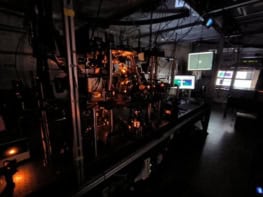
Physicists in the US believe that it is possible to generate solar power without solar cells. Their “optical battery” idea, which would involve performing the energy conversion inside insulators rather than semiconductors, could make for a far cheaper alternative energy source than existing solar-cell technologies.
In conventional solar cells, electricity is generated by simple charge separation. The semiconductor absorbs a photon of sunlight, knocking a negative electron into the material’s conduction energy band and leaving a positive hole in its place. With these two charges separated, a voltage is produced from which power can be drawn.
But solar power need not be generated in this way, according to Stephen Rand and William Fisher of the University of Michigan. Rand and Fisher have performed calculations to predict that voltages can be generated in insulating materials, using what they say is a previously overlooked aspect of light’s magnetic field. “You could stare at the equations of motion all day and you will not see this possibility,” says Rand.
Overlooked magnetic field
Light is an electromagnetic wave, which means that it has two components – an electric field and a magnetic field. In free space, the magnetic field is some eight orders of magnitude weaker than the electric field, almost so weak as to be negligible. Once it enters a material, then, the electric field accelerates charges – electrons – in its direction. Physicists had thought that the magnetic field would affect the dynamics of the electrons only when they approach very high “relativistic” speeds, close to the speed of light.
But Rand and Fisher have calculated that when electrons are bound to their nuclei, as they are in insulators, the electric and magnetic dynamics of the electron become linked, allowing energy to pass from one to the other. The result is that when light shines on an insulator, the magnetic field alone can shift electrons in the direction of the light, creating a polarization of charge. This acts much like an optical capacitor, which can be tapped for electricity – perhaps at efficiencies of around 10%.
“This method needs only simple dielectrics such as glass rather than highly processed semiconductors found in photovoltaic cells,” Fisher told physicsworld.com, adding that insulators in the shape of fibres would enhance the effect. “Glass is simpler and less expensive to manufacture; miles of glass fibre is pulled every day for fibre optics already.”
Not yet practical
Currently, Rand and Fisher’s work is mostly theoretical, and they think that the light would have to be focused to very high intensities of at least 10 million watts per square centimetre. However, they say that further experiments might reveal materials that work at lower intensities.
James Heyman, a semiconductor physicist at Macalester College in Minnesota, US, calls the work “interesting” but notes several potential drawbacks. “I don’t see evidence yet that the phenomena they study also occur at intensities corresponding to focused sunlight,” he says. And the projected efficiency already lags behind crystalline solar cells, he adds, which sell for about one dollar per watt in the US.
Still, the Michigan researchers have high hopes, even if, according to Fisher, it will be “many years” until optical batteries are on sale. “If we can develop a material that exhibits a strong effect at lower intensity and still be pulled as a fibre, the industrial capability already exists,” he says.
The research is published in the Journal of Applied Physics.



